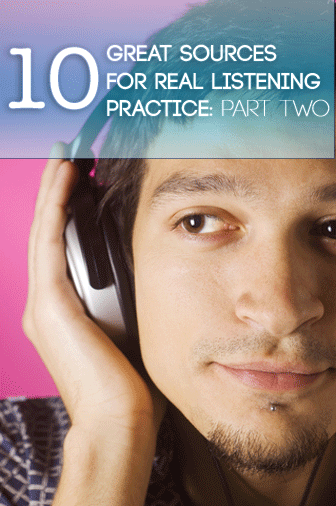10 Great Sources for Real Listening Practice: Part Two


In fact, it is often the most important aspect of language study for international students who come to U.S. English programs. More often than not, their experience has been limited to reading and writing, and even intermediate and advanced students may have the oral/aural levels of beginners. Exposing your students to many authentic types of language use is important, but there is good news. Here is a list of just a few real life materials you can use for listening practice. As the numbers on the list get higher, the challenge for your students increases, so pick a point along the spectrum and work your way to the more difficult resources!

Bringing a guest speaker into your classroom is a great benefit to your students. If you have taught ESL for any length of time, your speech has modified even if you do not realize it. Whether you know it or not, teachers of ESL naturally slow their speech, articulate more and exaggerate intonation. In fact, anyone who talks to a nonnative speaker does these things! A guest speaker will not have experienced that shift in pronunciation and speaking style if she does not work with internationals, so although your speaker may present a challenge to your students’ listening comprehension, it will also be a good time for them to practice. You can bring in a speaker on any topic that you are covering in class, or just bring in someone who has the free time to talk about something that interests them! Follow up with a general review of what the person said and how much your students were able to understand.
Another teacher makes for a good guest speaker, too, and you should be able to arrange a class swap fairly easily. When you have another teacher come and give your class a lesson, try to get someone who is not an ESL teacher and who is the opposite gender. Exposing your students to a different quality of voice is beneficial to their language learning process. If that teacher presents content material to your class, you can follow with a short quiz. If not, lead a class discussion asking what the other person said and what your class learned from him or her.
TV commercials are short and often simple. Though you may not want to advertise a particular product in your classroom, the actors use clear but somewhat natural speech that should be easier for your students to understand. Though they will not get some of the comprehension clues they would from a live speaker, they will still be able to see facial expressions and the context of the language. You may want to talk about how the advertisers try to communicate their message through the commercial. Before, after or while watching, you might want to point out specific vocabulary, words or phrases that may be unfamiliar to your students, especially slang, and challenge your students to guess the meaning of the words based on their context.
The next step up on the listening activity difficulty spectrum would be using a weather report that has appeared on the news. Though its benefits are similar to that of the commercial, there is less context for your students to infer meaning as they watch. After playing the report for your students two or three times, ask some comprehension questions to see just how much information they are absorbing. You can also ask about the symbols that the actor used as a visual message with his or her report and whether they aided your students’ understanding.
Movies and television shows are the next step up in listening comprehension practice. An entire movie may be too long both for your class periods and for how much information your students can take in at one time. Try to limit your selection to about ten minutes. With movies or television, your students still get visual input, but the speech will be more natural than the language used on news programs. In addition, you may have characters with accents, which will most likely be a difficult challenge for your students. After watching a segment two times, ask your students to write a summary of what happened in the scene. You can also review any unfamiliar vocabulary that was present or ask general comprehension questions.
The era of the cassette may be behind us, but that does not mean you should rule out radio clips as teaching aids! The benefit of radio voices in a news segment, weather segment or talk segment is that pronunciation is clearer, easier for your students to understand. The challenge with a radio clip will come with the lack of visual input that your students have to assist them. Surprisingly, being present where a conversation takes place is of great help for nonnative speakers and their comprehension, so taking away that visual will challenge your students. You can ask your students to listen for answers to specific questions or challenge them to infer the meaning of unfamiliar vocabulary from the context.
If you are looking for an even greater challenge for your students’ ears and minds, 10 Great Sources for Real Listening Practice: Part Two has five more sources you can use for listening practice!